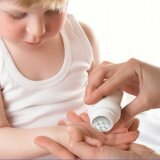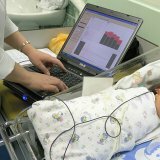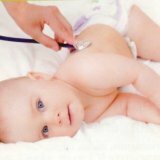Antibiotics for children with bronchitis

Severe symptoms of intoxication, as well as prolonged hyperthermia, are an indication for the use of antibiotic therapy in pediatrics in acute bronchitis. The presence of these symptoms is especially dangerous in the group of children with a dysfunctional premorbid background, which can lead to the development of the pneumonic process.
Antibiotics for children with bronchitis are prescribed only in the presence of clinical signs that indicate a bacterial inflammatory process( purulent and muco-purulent sputum) along with a pronounced intoxication.
Antibiotic therapy is also necessary for prolonged disease, especially if it is suspected that the pathogen is intracellular in nature.
Currently, 3 groups of drugs are widely used for the treatment of bronchitis: oral cephalosporins of the second generation, penicillin( aminopenicillin derivatives) and macrolides.
Aminopenicillins and penicillin( amoxicillin, ampicillin) exert their bactericidal action on pneumococcus, streptococci, certain types of staphylococci, as well as gram-negative bacteria, including morocellet catarrhas and hemophilic rod, but they are easily destroyed by beta-lactamases of pneumococcus, morocell and hemophilic rod.
Penicillin preparations do not affect intracellular pathogens. But they significantly affect the biocenosis of the intestine, resulting in an allergic reaction.
Oral cephalosporins( widely used 1 and 2 generation) - cephalexin, ceforaxime axetil, cefaclor, and strengths and weaknesses are the same as those of penicillin derivatives.
Cephalexin is easily broken down by bacterial β-lactamases, cefuroxime axetil and cefaclor are quite resistant to bacterial enzymes, relative to moroccel katarralis and hemophilic rod are quite effective. These drugs do not affect chlamydia and mycoplasma and can cause not only allergic reactions, but also expressed intestinal dysbiosis. But with streptococcal, staphylococcal, pneumococcal, gram-negative etiology, cephalosporin diseases are highly effective.
Macrolides, especially 2 and 3 generations, are significantly different from the
antibiotics of the two previous groups. Streptococcus, some types of staphylococcus, chlamydia and mycoplasma are well influenced by erythromycin. Take this medication 4 times a day, and this dramatically reduces the real adherence to treatment. It is especially difficult to observe this four-time intake of the drug, if the child is small.
erythromycin has an unpleasant taste, besides it has a high( about 23%) incidence of gastrointestinal side effects. Side effects are manifested in the form of nausea and vomiting, pain syndrome, diarrhea.
Macrolides 2 generations - spiramycin and 3 generations - azithromycin, josamycin, roxithromycin, clarithromycin do not have erythromycin-like deficiencies. They should be taken 2-3 times a day, azithromycin is taken once a day. These preparations have satisfactory taste qualities, especially children's sachets and suspensions. Side effects are manifested in 4-6% of cases. Macrolides exert an antibacterial effect on gram-negative bacteria that are topical in pediatrics: pertussis, campylobacter, diphtheria rods. These drugs have a weak side - it's their oral use, and this in severe cases limits the possibility of using macrolides. In addition, oral administration of the drug with enterobacterial and hemophilic etiology of the disease gives low effectiveness. Exception is only azithromycin, which has a high anti-hemophilic activity.
Antibiotics are prescribed empirically in bronchitis, therefore, some factors should be taken into account before choosing which one to prescribe: the child's age, intrauterine and out-of-hospital nature of infection, individual tolerability, the course of the disease( relapsing or prolonged), the symptoms, Then how effective it has been.



